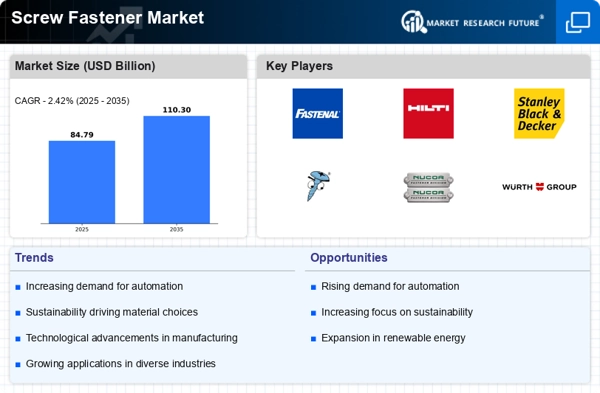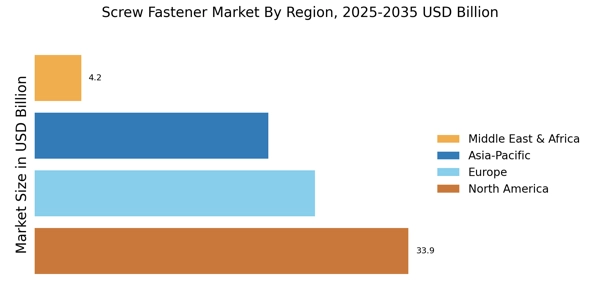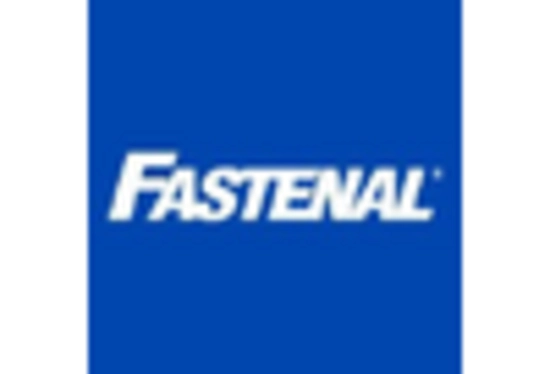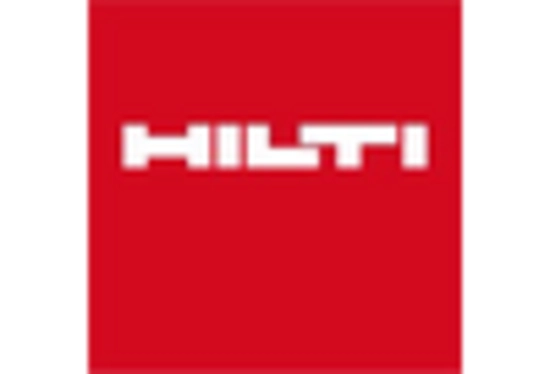Automotive Industry Expansion
The automotive sector plays a pivotal role in driving the Screw Fastener Market. With the rise in vehicle production and the shift towards electric vehicles, the demand for high-quality fasteners is expected to increase significantly. In 2025, the automotive industry is anticipated to witness a growth rate of around 4%, which will likely enhance the need for advanced screw fasteners that can withstand varying environmental conditions. This trend indicates that manufacturers must focus on developing specialized fasteners that cater to the unique requirements of automotive applications, thereby propelling the Screw Fastener Market forward.
Rising Construction Activities
The Screw Fastener Market is experiencing a notable surge due to increasing construction activities across various sectors. As urbanization accelerates, the demand for residential and commercial buildings rises, leading to a higher requirement for reliable fastening solutions. In 2025, the construction sector is projected to grow at a compound annual growth rate of approximately 5.5%, which directly influences the screw fastener demand. This growth is further fueled by government initiatives aimed at infrastructure development, which necessitate the use of durable and efficient fastening systems. Consequently, manufacturers in the Screw Fastener Market are likely to innovate and expand their product lines to meet the evolving needs of the construction sector.
Expansion of the Electronics Sector
The electronics industry is emerging as a significant driver for the Screw Fastener Market. With the proliferation of consumer electronics and smart devices, the need for precision fasteners is increasing. In 2025, the electronics sector is expected to grow at a compound annual growth rate of around 6%, which will likely boost the demand for specialized screw fasteners that ensure the integrity and reliability of electronic assemblies. This growth indicates that manufacturers must focus on developing innovative fastening solutions tailored to the unique challenges of the electronics industry, thereby enhancing their market position within the Screw Fastener Market.
Technological Innovations in Manufacturing
Technological advancements in manufacturing processes are transforming the Screw Fastener Market. Innovations such as automation, robotics, and advanced materials are enhancing production efficiency and product quality. For instance, the adoption of automated assembly lines is reducing labor costs and increasing output, which is crucial in meeting the rising demand. Furthermore, the integration of smart technologies in fastener production is enabling manufacturers to create more durable and reliable products. As a result, the Screw Fastener Market is likely to benefit from these technological improvements, leading to enhanced competitiveness and market growth.
Growing Demand for Renewable Energy Solutions
The Screw Fastener Market is also influenced by the increasing focus on renewable energy solutions. As the world shifts towards sustainable energy sources, the demand for wind turbines, solar panels, and other renewable energy infrastructures is rising. These applications require specialized fasteners that can endure harsh environmental conditions. In 2025, the renewable energy sector is projected to grow at a rate of approximately 8%, which will likely drive the demand for high-performance screw fasteners. This trend suggests that manufacturers in the Screw Fastener Market may need to adapt their offerings to cater to the specific requirements of the renewable energy sector.


















Leave a Comment